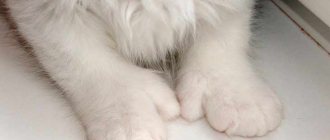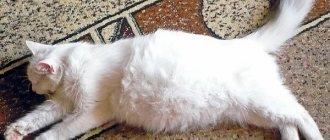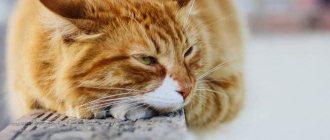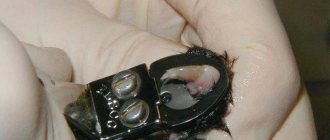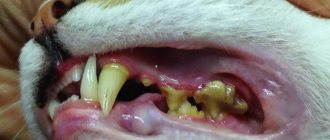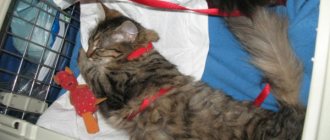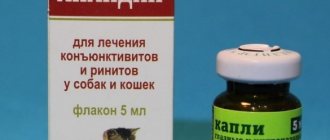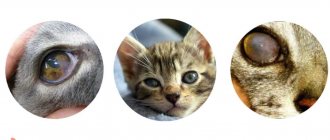When a cat appears in the house, many owners consider declawing along with sterilization. While the kitten is small, owners are concerned about several problems: litter box training, choosing the right food, and teaching order. By order we mean the moment to allocate a separate place for the baby to sharpen his claws, in order to avoid damage to furniture and repairs in general.
But as the kitten grows up, the problems get worse. His main weapon targets not only interior items, but also the owners themselves. It is then that even the most loving owners begin to think about this operation.
About the procedure
The procedure for declawing cats is affectionately known as “soft paws” and is scientifically known as an onychectomy. This is a surgical operation during which the animal's claw phalanx is completely removed. Onychectomy is performed not only on cats, but also on dogs, primates and even sometimes birds. Surgery takes place under general anesthesia.
Indications for such intervention in the life of an animal are only damage to the claw phalanx. Whether it is mechanical or due to a disease, if there is no way to save the “finger,” the veterinarian will definitely recommend amputating it.
Also, if we take into account biomedical ethics, an indication for the removal of all claw phalanges may be the cat’s uncontrollable aggression, which poses a threat to others. There are no other recommendations for performing the “soft paws” operation; this can only be the desire of the owner.
Consequences of the operation
Animal rights activists are unequivocally against such a procedure if it has no medical indications. They compare cat declawing surgery to removing the last phalanx of a human finger. In turn, doctors argue that this is an inappropriate comparison. However, after a total onychectomy, the cat experiences irreversible changes.
Here are the consequences you can notice in a cat after declawing:
- inflammation of soft tissues and even osteomyelitis (necrotic process);
- During the operation, the cat may lose a large amount of blood;
- the healing process, as a rule, turns out to be longer than predicted;
- the animal’s coordination of movements is impaired;
- the character of the cat changes, since the rehabilitation process takes a long time and is very painful;
- you need constant control over the animal so that it does not damage the stitches;
- the cat may not cope well with anesthesia;
- the pet begins to ignore the tray, because it will not be able to rummage through it as before.
These are just some of the unpleasant consequences of declawing. Of course, if there are medical indications for removal, then they should not be ignored. But it is also worth understanding that for medical reasons, a cat is not deprived of all its claws, but only sick or damaged ones are removed.
Rehabilitation
As with any surgery, your furry pet will need special care after declawing to get your cat back on her paws.
For normal rehabilitation of an animal you need:
- use painkilling injections only on the recommendation of a veterinarian;
- show the operated animal to the doctor every 3-4 days;
- the stitches need to be treated daily and the dressing changed;
- It is important to ensure that the cat does not remove the protective collar. You need to protect your pet from gnawing bandages and stitches.
On average, the recovery period takes 3-4 weeks. It is not recommended to remove claws for kittens under 7 months, but in fact, it is better to first sterilize the animal and analyze its behavior. Indeed, often, the decision to remove claws is not so necessary.
Cat grooming in Rostov-on-Don
The veterinary clinic "Doctor-Vet" provides services in Rostov-on-Don at a competitive price.
Cat's haircut "Dragon"
Cats are wayward animals and not every owner can trim them on their own. Therefore, it is easier to contact a specialist who has experience in this matter and can perform the service efficiently. As a rule, cats are cut for hygiene reasons, because animals are not able to care for their fur on their own. Especially when it comes to long-haired breeds. Grooming allows you to combat problems such as tangles and tangled hair. If the mats are not cut off, they cause a lot of inconvenience to the pet and can even lead to illness. Haircuts are also very relevant in the summer, when mustaches suffer from the heat.
Calling a groomer to your home will be an excellent solution for owners who do not have time to take their pet to a cat “beauty salon” and wait for it to be cleaned up.
So, the Doctor-Vet veterinary service provides the following types of services at home:
- Hygienic haircuts. This procedure is not performed for beauty, it is rather a necessity. As a rule, a hygienic haircut is aimed at removing tangles and tangled hair or combating skin diseases (fleas, dermatitis, etc.). Hygienic grooming is also recommended for animals in old age, when they cannot care for themselves. The hygienic haircut is called “Lion”, since after it the cat becomes like a lion (the fur remains only on the head). The Leo haircut is also considered a model haircut. It is very common today.
- Creative. Their main goal is to improve the appearance of the pet or to realize the owner’s fantasy. A creative haircut takes into account all the advantages and disadvantages of a pet and reflects its individuality. There are a great many options for creative haircuts. It all depends on the skill of the groomer, the characteristics of the animal and the imagination of the owner.
- Brushing cats. Combing involves removing shedding hair using professional, and most importantly, safe tools. The coat is not cut, but its volume is significantly reduced, and the appearance becomes more well-groomed and healthy. Special attention must be paid to removing tangles. Sometimes they do not need to be cut, but simply combed with a brush.
- The washing up. Washing a cat can be either a separate procedure or performed simultaneously with haircut and combing. Washing is not the easiest procedure, since cats do not like water and are afraid of it, and therefore it is not always easy for the owner to bathe his pet on his own. Our specialists will help you in this difficult matter. You will save time and nerves by inviting a groomer to your home.
It is advisable to groom cats 1-3 times a year. Of course, everything is individual and depends not only on the breed, but also on the animal’s body (how quickly the fur grows, what is the degree of thickness of the fur, etc.).
Since the climate in Rostov-on-Don is quite hot and in the summer the temperature can rise to 40 degrees, we recommend cutting your hair before the heat sets in. This will reduce the animal's discomfort to a minimum.
Before the procedure, it is recommended to trim the cat’s claws so that it does not injure the owner’s master during and after the procedure.
How much does cat declawing surgery cost?
The price of a total onychectomy varies depending on the level of the clinic and its location. For example, in Moscow and the region the cost ranges from 1.5 thousand rubles to 5. In the regions, prices may be lower.
If you decide to have such a serious operation on your pet, you should not save money. It is better to make a choice in favor of a clinic that specializes in surgery. It’s even better to choose one where it is possible to call a doctor at home. If the operation is performed in a familiar environment for the cat, he may recover faster.
Reviews
Reviews from owners about declawing cats, as well as opinions about the advisability of the procedure, vary greatly. Below are several reviews from owners who decided to undergo this complex operation.
Victoria, Barsik's owner:
“Our Barsik has always been a calm and beloved cat. But at some point he began to show unjustified aggression towards his husband and some other household members. We were never able to establish the cause; cat sedatives did not help. Having lost a long battle, we made a desperate decision - to deprive Barsik of his claws. The operation was successful, rehabilitation took a little over a month. The cat changed completely, became calm, even somewhat unsociable. Activity has decreased greatly. I can’t say that I regret the operation, since our problem was completely resolved.”
Marina, owner of Sonya and Kitty:
“Sonya has always been a calm cat. A few years later we decided to make her a girlfriend. That's how we got a Kitty. The girls quickly became friends, but sometimes they still fought. One day, Sonya scratched the youngest one very badly; she even had to resort to the help of a veterinarian. That's when we decided to remove Sonya's claws.
The operation went well, but the rehabilitation period was extremely difficult. The cat was lethargic, her appetite was weak, there was not a hint of affection left. Over time, Sonya began to boldly walk on her paws, but a slight limp remained. Her jumps were timid, and she could not balance on high shelves. Sonya began to completely ignore the tray. Of course, we have solved the issue of cat fights once and for all, but we have completely lost our favorite. I really regret taking this step.”
Cat grooming prices
Prices for such services in Rostov-on-Don may vary and often depend on the wishes of the master himself. When contacting the Doctor-Vet veterinary clinic, you can be sure that there will be no surprises regarding the price of a haircut. We announce the cost over the phone and it does not change during the work process! We only employ experienced hairdressers who can cut even the most wayward cat's hair. After the procedure, the specialist will give recommendations for further care and answer all your questions. Groom your cat yourself or seek help from specialists - the decision is yours. The main thing is to provide your pet with timely care for its coat and monitor its health. The price for grooming a cat is 1000 rubles.
Is it possible to trim cats' claws?
Cat claws are a problem for opponents and victims of the animal, although humans are also often attacked by this formidable weapon. It would seem that the problem can be solved by simply trimming the claws of a pet, but in cats this is not always useful, and sometimes even dangerous. On the other hand, a haircut is sometimes a necessity - how and when it is done, let’s try to figure it out now.
Content
To cut or not to cut?
The anatomy of a cat's claws is such that each of them contains a nerve and a blood vessel. This means that banal nail trimming is strictly contraindicated. But in some cases, if the rules are followed, such an operation will still be needed. This can be done for a practical purpose - if a pet constantly clings to carpets, upholstered furniture, clothes and other things, there is a risk of completely tearing off its claw. The claw on the fifth toe, which is located on the animal’s front paws, is also often trimmed. It can grow so long that it pricks the pad with the risk of causing injury. Some breeds may have specific nail abnormalities, such as Britons, Sphynxes or Persians. The latter are generally distinguished by an almost universal predisposition to the appearance of problems with claws, especially if the animal is already aged. So cats need to have their claws trimmed, although not in all cases.
Trimming nails: is it possible or not?
Veterinarians at the RosVet VC talk about the need to trim claws when a cat lives permanently in the house (as well as about oophorectomy). This can be avoided if you equip your pet with a special place for the claw point - a board, a piece of log, a corner covered with a hard rug.
But not all animals want to use the “correct” scratching post and, with persistence that drives owners crazy, they grind off their overgrown claws on wallpaper, sofas, and carpets. In this case, it makes sense to go to a veterinary clinic and trim the overgrown claws.
How many claws does a cat have?
Most often they claw on the front paws, forgetting that the pets’ hind paws are no worse. Need pruning: 4 pcs. on the front legs, 4 pcs. on the hind legs. There are 2 more claws, hidden from the owner’s eyes and therefore causing problems for animals. We are talking about the claws on the fifth toes, rudimentary processes that are not full-fledged fingers, but have a fully formed claw. It is very rare on the hind legs, but there is also a 5th toe, so when trimming the cat’s claws, each paw is carefully examined.
How often should I do this?
It should be noted right away that this procedure can only be done on adult animals—cutting kittens’ claws is prohibited. This should be done as the horny part of the claw grows, approximately once a month. It is important to carefully ensure that only the horny part of the claw is trimmed - this is exactly what needs to grow back. A cat's instinct will be to sharpen its claws, so trimming may not be necessary at times. If there is no need to do this, of course, there is no need to do this, you just sometimes need to examine the animal’s paws, especially the claws on the fifth toes.
How are the claws of cats and cats arranged?
A cat's claws are sickle-shaped for capturing prey, climbing trees, or defending itself during a fight. The part that we see is penetrated almost to the very tip with nerve endings and vessels, and at the tip there is a keratinized part that is constantly renewed. It is to renew it that cats sharpen their claws.
By cutting even a small section of a cat's claw, you can, without meaning to, hurt the animal and injure the claw. Don't forget that after using the toilet, cats scrabble after themselves, and improperly trimmed claws can become infected. Infected claws lose strength, peel and cause discomfort to cats.
Is it possible to trim nails at home?
You can do this procedure at home, although it is quite difficult, especially if you do not have the skills and the necessary accuracy. It is not advisable to trim cat's claws with ordinary scissors, since their shape is not intended for such operations. Nail clippers are also not suitable, especially since they are really difficult to determine the required trim size. You can see the vessel in the claw in the light - you need to cut it off so as to leave about 3-4 mm to it. To do this, you will need a special nail clipper with the required shape. The cat, of course, will not be happy with such a procedure; it will break out, twirl and bite, so without proper skill, you can cut the surface incorrectly. The claw should be cut in such a way that only the horny part is removed and the blood vessel is not affected.
Why do you need to cut your hair?
Nature has taken care of every living creature, and a cat’s claws were not given for beauty. In natural habitats, claws help a cat hunt for prey and escape from stronger opponents. With the help of its claws, the animal easily climbs a tree, escaping the dog and other enemies. But why do they need a domestic cat, who sees the whole world only from the apartment window?
Many owners believe that claws only bother a cat. And you can’t count how many troubles they cause for owners of furry pets:
- cling to carpets, curtains, upholstered furniture;
- During games, they can accidentally or deliberately scratch or injure a person.
Untrained cats often mistake a sofa, armchairs or carpet for a scratching post. And even if you place scratching posts in every room, the pet will leave marks of sharp claws on the furniture. There is only one way out - trim the claws so that they are not so sharp.
For animals participating in exhibitions, trimming their nails is a mandatory procedure. It is also recommended to do this:
- before mating;
- a visit to the veterinarian.
Small kittens, although they still have softer claws than adult cats, are also recommended to trim them so as not to injure the mother cat during feeding, and at the same time accustom them to manipulation. The sooner this is started, the less resistance the owner will encounter from the pet later during cosmetic procedures.
Important!
In no case should the claws of cats that have the opportunity to walk outside be trimmed: this can deprive them of the ability to defend themselves, which can lead to serious injuries and even death of the pet.
It is better to entrust the procedure to professionals
In a professional veterinary center, this operation will be performed quickly and safely for the animal. The experience of the master will allow you not to injure either the paws or the psyche of the animal. The procedure is inexpensive and not difficult for a professional, so it is better to get a cat “manicure” done in a specialized salon.
How does the procedure work?
First of all, the animal must calm down and get used to the master a little. The following is done:
- The animal is carefully held in the hands;
- Light pressure on the paw pad exposes the claw;
- A special tool is used to trim the horny part with the necessary distance from the blood vessel and nerve;
- If necessary, use a special file for grinding;
- The paw is disinfected.
The owner is nearby at this time, you can even perform the operation in such a way that the cat is in his arms - this way the animal will tolerate the procedure more calmly. In general, nail trimming takes no more than 5 minutes. If a cat has certain pathologies, injuries or diseases of the pads or the claws themselves, additional treatment may be necessary, for example, with various medications.
Tools
To trim cat claws, a special nail clipper is used, which allows you to remove the horny part at the required angle without touching important parts. A sanding file can be used. Tools of different sizes are used, depending on the age and size of the animal. All instruments are required to be sterilized before and after each operation. In his work, the master uses disinfectants that are safe for the health of the animal. The procedure is carried out with maximum care and attention to the cat.
How to cut your hair correctly
You can start trimming your kitten's nails as early as 2-3 months of age. At this time they are still soft, by six months the claws harden. A convenient time for cutting is after feeding and playing. The kitten wants to sleep and will not resist, so the procedure will be harmless for both the animal and its owner.
Advice!
To accustom a kitten, during games and petting, gently stroke its paws, massage the pads, lightly pressing on them and stimulating the appearance of claws.
For the procedure, it is best to purchase a special nail clipper, but you can also use regular nail scissors or tweezers. Scissors are not always convenient - trimming hard nails on adult pets will require effort. It is not recommended to use scissors with rounded ends, as they can injure the paw pads.
In addition to scissors, you need to prepare a nail file, a cotton pad and oxygen peroxide - they will be needed in case of possible injuries to disinfect and stop bleeding.
If the kitten has been accustomed to the procedure since childhood, you can handle it alone; if it actively resists, it is better to attract an assistant to calm and hold the cat to avoid injury. Particularly active ones can be swaddled during cosmetic procedures, but if the cat desperately resists, it is better to postpone the manipulation or have it done in a veterinary clinic.
Important!
On the front paws, you need to trim the claws at least twice a month; on the hind paws, once is enough.
Before work, disinfect tools and wash your hands thoroughly. Choose a bright place in the room, calm the cat, then take its paw in your left hand, press on the pad: the pet will release its claws. Please note that in cats, blood vessels and nerve endings are located very close to the regrown part of the claw, so trimming should be carried out no closer than 2 mm to the pink part of the claw. If the claws are too hard, you can lightly file the edge.
At the pet store you can buy a special tool for caring for cat claws - a nail clipper. It has a curved shape and makes the procedure safe. There are several types of nail clippers:
- special nail clippers-scissors. They cover the perimeter of the claw and prevent damage.
- forceps. They have a limiter that does not allow cutting off too much of the claw, and they make a high-quality cut, eliminating the delamination of the claw plate;
- “guillotine” – must be used with caution, since it is difficult to control the manipulation;
- electric grinder. A professional tool for groomers and veterinarians.
It is most convenient to use forceps, directing their movement at an angle, so that after trimming the claw has a sharp end, similar to an “arrow”. Before doing this, carefully examine the claw to determine where the blood vessel is located. If it is accidentally damaged, treat the wound with hydrogen peroxide.
After manipulation, lightly polish the sharp edges of the claw with a nail file. After the procedure, be sure to pet your pet and treat him with his favorite treat. Then he will develop a good instinct, and the cat will not perceive the following manipulations as something unpleasant.
Important!
Some breeds require more frequent nail trimming. In Persians and Sphynxes they grow much faster, so you should regularly inspect your pet’s paws and decide whether to cut it or not.
It is difficult to accustom some animals to hygiene procedures. It is not always possible to calm them down with affection or treats. Sometimes aggression during trimming a pet's nails is explained by the fact that he was once hurt. As a result, an instinct has developed, so it is recommended to either cut such animals together or carry out cosmetic manipulations in a veterinary clinic. Specialists know how to find an approach to any animal and will trim the claws of even the most obstinate cat.
